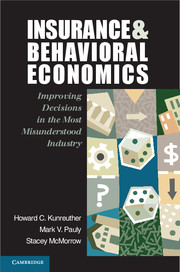Book contents
- Frontmatter
- Contents
- Preface
- Acknowledgments
- Part I Contrasting Ideal and Real Worlds of Insurance
- Part II Understanding Consumer and Insurer Behavior
- 5 Real-World Complications
- 6 Why People Do or Do Not Demand Insurance
- 7 Demand Anomalies
- 8 Descriptive Models of Insurance Supply
- 9 Anomalies on the Supply Side
- Part III The Future of Insurance
- Notes
- Glossary
- Bibliography
- Author Index
- Subject Index
7 - Demand Anomalies
Published online by Cambridge University Press: 05 February 2013
- Frontmatter
- Contents
- Preface
- Acknowledgments
- Part I Contrasting Ideal and Real Worlds of Insurance
- Part II Understanding Consumer and Insurer Behavior
- 5 Real-World Complications
- 6 Why People Do or Do Not Demand Insurance
- 7 Demand Anomalies
- 8 Descriptive Models of Insurance Supply
- 9 Anomalies on the Supply Side
- Part III The Future of Insurance
- Notes
- Glossary
- Bibliography
- Author Index
- Subject Index
Summary
This chapter discusses significant anomalies in the demand for insurance using the benchmark model of demand as a reference point. It then explains many (but not all) of these anomalies by invoking the theories of choice and behavior outlined in Chapter 6. The unexplained anomalies remain puzzles for the reader to reflect on. The chapter includes a discussion of several general demand-side anomalies followed by a detailed analysis of a few specific insurance markets likely to be affected by these anomalies. It is worth restating here the three broad types of demand-side anomalies explained in Chapter 3:
Inadequate demand at reasonable premiums (underpurchase);
Large demand at excessive premiums (overpurchase);
Purchasing the wrong amount or type of coverage.
SEVEN ANOMALIES
The following examples of anomalies can occur across a variety of insurance markets.
Failure to Protect against Low-Probability, High-Consequence Events
Many people fail to purchase protection against relatively rare but serious losses offered at market premiums unless they are required to do so by stipulations in lending agreements such as buying homeowners’ insurance as a condition for a mortgage. Although the probability of an individual incurring a loss is low, the pool of individuals at risk for such events is large. For victims, the financial protection from insurance can make the difference between recovery of their normal pattern of consumption and deep and continuing difficulties.
- Type
- Chapter
- Information
- Insurance and Behavioral EconomicsImproving Decisions in the Most Misunderstood Industry, pp. 113 - 144Publisher: Cambridge University PressPrint publication year: 2013



